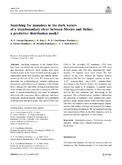Searching for manatees in the dark waters of a transboundary river between Mexico and Belize: a predictive distribution model

View/
Date
05-11-2020Author
Corona-Figueroa, M. Fabiola
Ríos, Ney
Castelblanco-Martínez, Delma N
Vilchez-Mendoza, Sergio J
Delgado-Rodríguez, Diego
Niño-Torres, Carlos A
Type
Artículo
Metadata
Show full item recordAbstract
Antillean manatees in the Hondo River have been recorded from aerial and aquatic surveys, and interviews. However, these studies have been conducted only in the lower riverbed, leaving a gap of information about their presence and habitat characteristics in the rest of the river. We characterize and determine the ecohydrological variables influencing the presence and habitat use of manatees in the Hondo River. During 2017 and 2018, 30 based-boat field trips were conducted in five consecutive transects of 15 km each. A mixed methodology was used for manatee detection: side-scan sonar, direct sightings, and feces collection. Ecohydrological variables were measured in all transects and fixed points. The survey effort was 136.5 h. We recorded 123 manatees: 47% were observations during the boat-based surveys, 29% were at fixed points, and 24% were opportunistic. Additionally, 10 manatee feces were found. The first transect of the river showed the highest relative abundance for the two sampled seasons (windy = 0.27 manatees/km, dry = 0.55 manatees/km). According to the Poisson model, the estimated population was equal to 51 manatees. A random forest model suggested high probability of observing manatees in the first transects and decreasing at the upstream. The ecohydrological variables influencing the detection of manatees were conductivity, transparency, depth, and proximity to the Four Mile lagoon. The first two transects have ecohydrological characteristics that makes a benign environment for refuge, rest and feeding of manatees. We recommend carrying out conservation efforts in the first transects, such as protection and the regulation of boat transit.
Keywords
Publisher
Springer, Nueva York (Estados Unidos)
Is part of
Aquat Ecol
URI (Permanet link to cite or share this item)
https://doi.org/10.1007/s10452-020-09810-9https://repositorio.catie.ac.cr/handle/11554/10267

